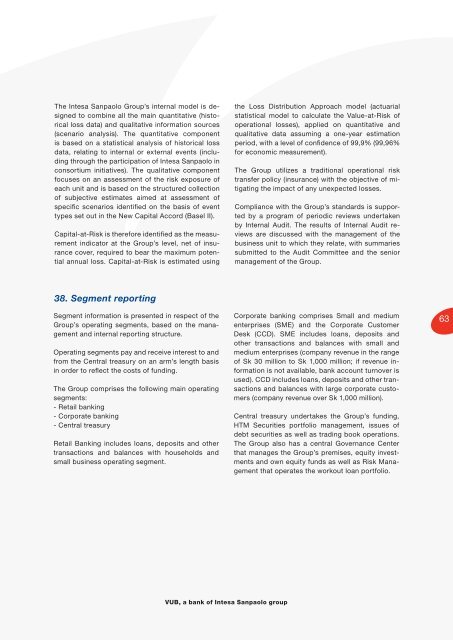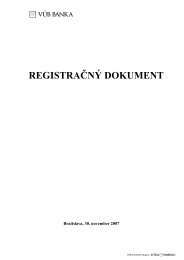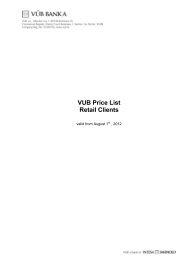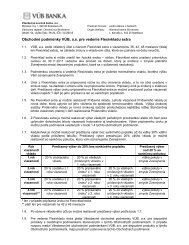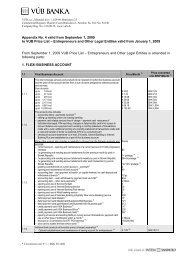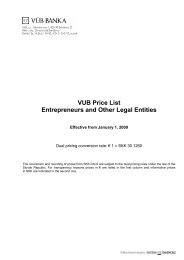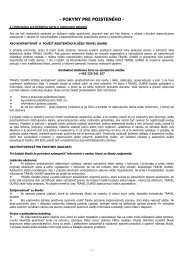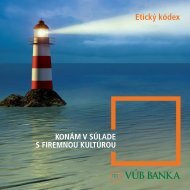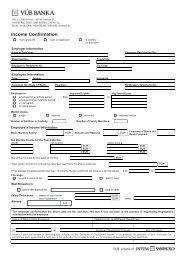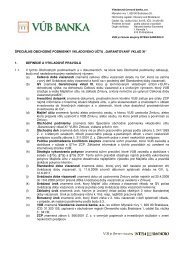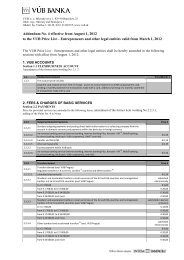Annual Report - VÃB banka
Annual Report - VÃB banka
Annual Report - VÃB banka
Create successful ePaper yourself
Turn your PDF publications into a flip-book with our unique Google optimized e-Paper software.
The Intesa Sanpaolo Group’s internal model is designed<br />
to combine all the main quantitative (historical<br />
loss data) and qualitative information sources<br />
(scenario analysis). The quantitative component<br />
is based on a statistical analysis of historical loss<br />
data, relating to internal or external events (including<br />
through the participation of Intesa Sanpaolo in<br />
consortium initiatives). The qualitative component<br />
focuses on an assessment of the risk exposure of<br />
each unit and is based on the structured collection<br />
of subjective estimates aimed at assessment of<br />
specifi c scenarios identifi ed on the basis of event<br />
types set out in the New Capital Accord (Basel II).<br />
Capital-at-Risk is therefore identifi ed as the measurement<br />
indicator at the Group’s level, net of insurance<br />
cover, required to bear the maximum potential<br />
annual loss. Capital-at-Risk is estimated using<br />
the Loss Distribution Approach model (actuarial<br />
statistical model to calculate the Value-at-Risk of<br />
operational losses), applied on quantitative and<br />
qualitative data assuming a one-year estimation<br />
period, with a level of confi dence of 99,9% (99,96%<br />
for economic measurement).<br />
The Group utilizes a traditional operational risk<br />
transfer policy (insurance) with the objective of mitigating<br />
the impact of any unexpected losses.<br />
Compliance with the Group’s standards is supported<br />
by a program of periodic reviews undertaken<br />
by Internal Audit. The results of Internal Audit reviews<br />
are discussed with the management of the<br />
business unit to which they relate, with summaries<br />
submitted to the Audit Committee and the senior<br />
management of the Group.<br />
38. Segment reporting<br />
Segment information is presented in respect of the<br />
Group’s operating segments, based on the management<br />
and internal reporting structure.<br />
Operating segments pay and receive interest to and<br />
from the Central treasury on an arm’s length basis<br />
in order to refl ect the costs of funding.<br />
The Group comprises the following main operating<br />
segments:<br />
- Retail banking<br />
- Corporate banking<br />
- Central treasury<br />
Retail Banking includes loans, deposits and other<br />
transactions and balances with households and<br />
small business operating segment.<br />
Corporate banking comprises Small and medium<br />
enterprises (SME) and the Corporate Customer<br />
Desk (CCD). SME includes loans, deposits and<br />
other transactions and balances with small and<br />
medium enterprises (company revenue in the range<br />
of Sk 30 million to Sk 1,000 million; if revenue information<br />
is not available, bank account turnover is<br />
used). CCD includes loans, deposits and other transactions<br />
and balances with large corporate customers<br />
(company revenue over Sk 1,000 million).<br />
Central treasury undertakes the Group’s funding,<br />
HTM Securities portfolio management, issues of<br />
debt securities as well as trading book operations.<br />
The Group also has a central Governance Center<br />
that manages the Group’s premises, equity investments<br />
and own equity funds as well as Risk Management<br />
that operates the workout loan portfolio.<br />
63<br />
VUB, a bank of Intesa Sanpaolo group


